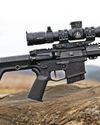Training in the cold at high altitude.

While at this time of year you’re probably thinking about summer vacations, grilling, and yard chores, the fall isn’t too far off.
Many of us will be heading afield to fill the freezer, and while not everyone gets the chance to go on an extreme mountain hunt, training like you’ll be working at altitude and in the cold pays dividends. Not a hunter? Maybe you’re going hiking somewhere, climbing, or perhaps you just love the idea of a HALO (high altitude low opening) jump into northern British Columbia where you’ll be in the mountains for days. Now’s the time to consider changes to your training regimen — leave it until a couple of weeks before and you’ll be way behind the curve. This last scenario, in particular, poses a higher risk for cold-related problems because the exposure is for a prolonged amount of time. Regardless, don’t worry, though. We have you covered.
COLD
Responses: The first step to preparing yourself for the cold is knowing how the body responds to it. It’s important to point out that the human body gains heat through radiation (from the sun), metabolism, and muscle action, with muscle being the most substantial source. Therefore, the amount and intensity of movement can be crucial to staying warm in a cold environment. Without much movement occurring, you’re not going to get a substantial amount of heat either through muscle contractions or metabolism because the increase in movement also causes increases in metabolism.
This story is from the July - August 2019 edition of Recoil.
Start your 7-day Magzter GOLD free trial to access thousands of curated premium stories, and 9,000+ magazines and newspapers.
Already a subscriber ? Sign In
This story is from the July - August 2019 edition of Recoil.
Start your 7-day Magzter GOLD free trial to access thousands of curated premium stories, and 9,000+ magazines and newspapers.
Already a subscriber? Sign In

THE 'PARTNER FORCE' AK
A First-hand Look at the AKs of Afghan Commandos

THE SCAR WITHOUT FN
The Self-Assembled Modular SCAR 17

WATER DRAGON - THE GREY GHOST 6ARC DRAC
The Latest Long-Range 6ARC Rifle, Developed on the Range

QUARTER CIRCLE 10 YKMF-5
When an MP5 Isn't

THE GOOD, THE BAD, AND THE SILENT
Tactical Cowboy by Heritage Manufacturing

FOLDING FRONT-END FIREPOWER
AR-15 Takedown Systems for Compact Capability

CANADA'S NATIONAL FIREARMS ASSOCIATION
The NFA is Leading the Way to Fight for Gun Rights in Canuck Country

BEST OF SHOT SHOW 2022
Bear in mind that just because a product received an award doesn't mean it has our endorsement (by default everything awarded is new), but you'll be seeing more of everything you see here in these pages in upcoming issues.

BFT47 AK
Has Century Managed to Produce a Working American AK? We Put Their Latest Version to the Test

ANGSTADT ARMS MDP-9
Move Over MP5, There's a New Roller Locked Subgun in Town